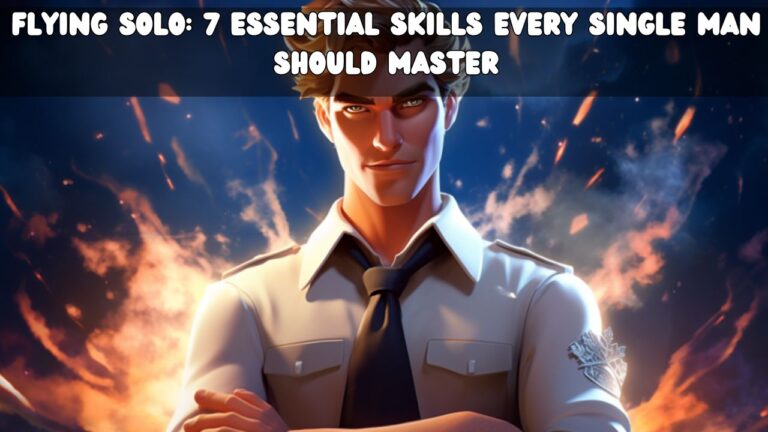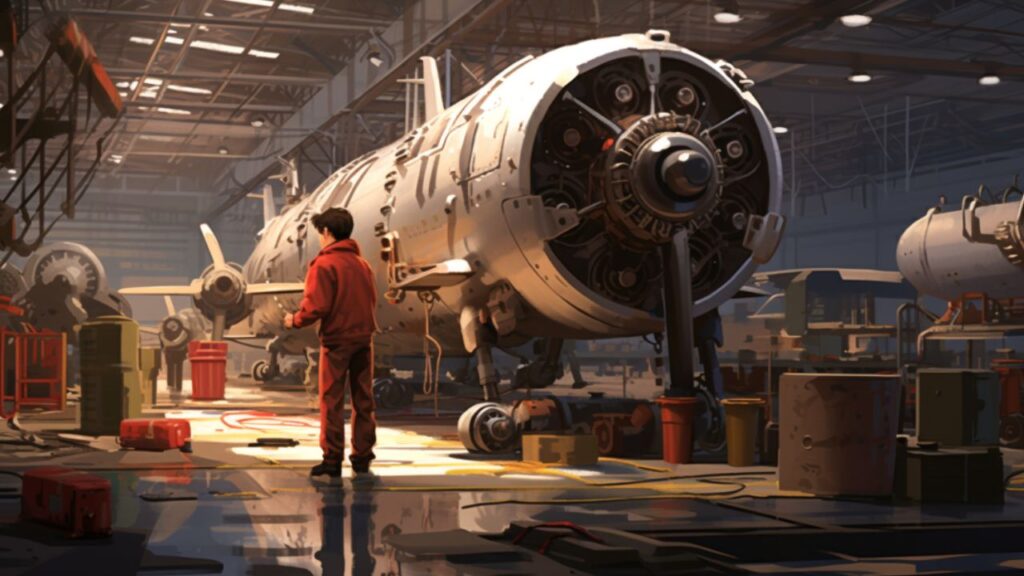
As I take to the skies in my solo adventures, I’m constantly reminded of the parallels between the solitary flight of an aviator and the journey of a single man in today’s bustling world. Both are endeavors filled with unique challenges and freedoms, opportunities to explore uncharted territories, and the joy of self-discovery. Navigating this single journey requires more than just the wings of independence; it demands the skills to thrive on one’s own.
The societal script often dictates that singlehood is a phase, a temporary stopover before settling into the companionship of a relationship or family. However, like many fellow lone navigators, I’ve come to see single life not as a transitory state but as an art form in itself. Embracing the solo journey is about more than just celebrating freedom—it’s about cultivating the skills to be genuinely self-reliant.
Now, don’t get me wrong, relationships and companionships are beautiful in their own right. Yet, there’s a certain empowerment in being able to stride confidently on your own two feet, knowing you can cook a hearty meal for yourself, manage your finances astutely, and address challenges head-on, without always leaning on someone else. This self-sufficiency doesn’t negate the need for human connections; instead, it complements them, allowing you to enter relationships not out of dependence but from a place of strength and self-assurance.
Flying solo offers unparalleled opportunities for personal growth. Like an aviator charting a course across the vast skies, a single man can carve out his path, free from the co-pilot’s influences. But with this freedom comes responsibility. Mastery over essential life skills is not just about ticking off a checklist; it’s about enhancing the quality of one’s journey.
From understanding the nuances of one’s emotions to tackling everyday tasks with finesse, the process of honing these skills is transformative. It’s about the evolution of the self, evolving from a passive passenger in life to an active pilot, steering one’s destiny with clarity, purpose, and skill.
In the subsequent sections, we’ll embark on this enlightening expedition together, uncovering the core competencies that every modern single man should possess. Join me, LoneAviator, as we dive deep into mastering the art of singlehood, charting courses, and soaring beyond societal norms.

Like a pilot preparing for a long flight, I believe every man should be equipped with the essentials to sustain his journey. And in my adventures both in the skies and on the ground, I’ve found that there’s nothing more fundamental than the food we consume. To me, the art of cooking is a lot like flying—it’s a harmonious blend of technique, intuition, and passion.
Navigating through life’s daily hustle and bustle, I’ve often found it easy to overlook the very fuel that powers my journey—food. Being single, it’s sometimes tempting to grab takeout or settle for packaged meals. But taking the time to truly understand and master the basics of nutrition and cooking has not only been a transformative skill for me; it’s become a rite of passage.
For me, healthy, balanced meals are the propellers that keep my engine running at its peak. They cater to my physical well-being, and I’ve discovered they play an immense role in my mental health too. The very act of cooking, for me, is therapeutic—a meditative practice that offers solace from the daily grind. Plus, having a hand in what goes into my meals has given me the autonomy to nourish my body with quality ingredients, ensuring I’m always ready for life’s next adventure.
When I first set foot into the culinary world, I’ll admit, it felt daunting. The myriad of ingredients, techniques, and cuisines seemed vast and overwhelming. But just like mastering the controls of an aircraft, I realized it all starts with the basics.
I began with simple dishes that didn’t demand an array of ingredients or sophisticated techniques. A classic spaghetti aglio e olio or a hearty omelette became staples in my kitchen. As I gained confidence, I began experimenting, playing with flavors, and expanding my culinary horizons.
In the sections to come, I’ll share some of my go-to, flight-ready recipes. These dishes won’t just quench your hunger; they’re sure to impress anyone you invite to join you on your culinary journey.
So, as I always say, “Strap in, prep those ingredients, and let your culinary adventures take flight!”

As an aviator, my flights demand rigorous planning and keen foresight. Just a small deviation from the plan, or a little oversight, can lead to unexpected turbulence. Similarly, navigating the vast expanse of personal finances requires a clear roadmap and disciplined execution. Whether you’re managing your monthly expenses or charting out long-term investments, a sound understanding of money matters is crucial. Here’s how I’ve approached it:
When I first started flying solo in life, the financial clouds seemed quite foggy. Income came in, expenses went out, and sometimes, it felt like a turbulent spiral. But then, akin to how I’d approach a new flight path, I took charge, plotting out my monthly expenditures and income.
The first step for me was to understand where my money was going. Tracking every expense, no matter how minor, gave me clarity. Slowly, I began categorizing these expenses – essentials, luxuries, and the occasional splurges. By visualizing my spending habits, I could then set limits and prioritize.
Living within my means didn’t signify skimping on experiences or being excessively frugal. For me, it was about making informed choices. Do I buy that expensive gadget now or hold off until I’ve saved enough? Do I splurge on a luxurious trip, or could I plan a budget-friendly adventure that’s equally fulfilling? Every decision grounded in awareness and foresight ensured that I stayed on course, even during unexpected financial gusts.
Once I had a grip on my budget, I turned my gaze towards the horizon. As I often say, “Why aim to skim the treetops when you can soar amongst the stars?” For me, this wasn’t just about having a savings account; it was about building a foundation for my future.
Savings became my safety parachute, ensuring that I had funds to fall back on during unplanned circumstances or turbulent times. But then, I pondered – why let the money sit idle? This led me to the realm of investing. While initially intimidating, with research, consultation, and small, cautious steps, I ventured into stocks, bonds, and even mutual funds.
Investing, I realized, was a lot like piloting. It demands patience, constant learning, risk assessment, and sometimes, trusting your gut. And while the skies aren’t always clear—with market dips and economic downturns—over time, with a balanced and informed approach, I’ve found that the sky truly is the limit.
To all my fellow solo navigators out there: chart your financial flight plan, stay informed, and always be ready to adapt. The world of finances is vast, but with the right approach, you can soar to unimaginable heights. Safe flights!

Flying an aircraft demands a sound understanding of every little part and system onboard. Much like how an aviator has to be familiar with the maintenance and upkeep of their aircraft, managing our own living spaces requires attention to detail and the ability to address issues head-on. As I’ve transitioned through life, I’ve come to view my home as my personal hangar – a safe, well-maintained base where I recharge, reflect, and prepare for the next adventure. Let’s dive into the essentials:
In the early days of living on my own, I faced a fair share of minor home issues – from a wobbly table leg to a leaky faucet. It can feel daunting, but like my time in the cockpit, I realized the importance of understanding the basics. For most common repairs, you don’t need to be a DIY guru; just a bit of knowledge and the right tools.
I’ve armed myself with a basic toolkit – a screwdriver set, a hammer, some pliers, and a few other essentials. These have been instrumental in addressing minor fixes around the home. Whether it’s tightening a loose screw, hanging up a picture frame, or even replacing a blown fuse, having the confidence to tackle these tasks has been liberating.
Every now and then, our personal hangars may need a fresh coat of paint or some basic plumbing attention. I remember the first time I decided to repaint a room; it felt like prepping for a major flight mission. But with some research and guidance, it turned out to be a rewarding experience. My advice? Always prep your workspace, invest in quality brushes and paint, and take your time.
Then there’s the inevitable clogged drain. In my experience, a simple mixture of baking soda followed by vinegar, left to sit for about 30 minutes, and then flushed with hot water often does the trick. It’s eco-friendly and usually avoids the need for strong chemical solutions.
Maintaining my personal space, my hangar, has become a source of pride and contentment. Sure, there’s a learning curve, but the satisfaction of solving issues, adding personal touches, and creating a comfortable sanctuary is unparalleled. To my fellow solo flyers: don’t shy away from these tasks. Embrace them, learn from them, and watch your personal hangar become a true reflection of you. Ready for the next maintenance task? I know I am!

Flying has taught me many things, and not all lessons come from the technical intricacies of aircraft or the challenges of weather patterns. Much like the vast skies I navigate, the human heart and mind are vast and complex. Emotional intelligence, I believe, is the compass that every individual – especially single men like me – needs to navigate the often turbulent skies of personal relationships and self-understanding. Let’s delve into the intricate aspects of this vital skill:
Every aircraft has its instruments, gauges, and dials that give real-time feedback, allowing pilots to adjust and navigate effectively. Similarly, I’ve come to see my emotions as signals, each conveying a unique message about my internal state.
Over the years, I’ve made it a mission to tune into these emotional signals, to truly understand what triggers feelings of happiness, sadness, anger, or anxiety. Once, after a particularly challenging solo flight, I realized that the stress wasn’t just due to the flight conditions but was amplified by my underlying feelings of loneliness. Recognizing such links has been pivotal. It enables me to address the root causes, take corrective actions, and steer my emotional well-being in the right direction.
In aviation, building bridges isn’t about constructing physical pathways but about forging connections between different entities: pilots, ground staff, control towers, and more. Drawing from this, I’ve come to understand the importance of building emotional “air bridges” with the people around me.
Empathy has been my guiding light. By genuinely putting myself in another’s shoes, I’ve not only deepened my understanding of their feelings but have also learned so much more about my own emotional landscape. Effective communication follows naturally when empathy is at the forefront. I’ve worked on actively listening, sharing my feelings transparently, and always ensuring a two-way flow in conversations.
Whether it’s with family, friends, or significant others, these emotional connections have become my lifeline. Strengthening these bonds has provided me with support during the solo phases of my journey, making every flight, both literal and metaphorical, a shared adventure.
In our solo flights through life, our emotional intelligence becomes the radar that detects upcoming storms, the compass that guides us through them, and the radio through which we reach out. It’s a continuous journey of self-discovery and connection. Are you ready to navigate your emotional skies?

Flying has often reminded me that while the skies may seem endless, time is not. In the cockpit, every second counts. Delays, inefficiencies, or poor planning can lead to missed opportunities or, worse, perilous situations. Drawing a parallel to our daily lives, time management becomes our navigational tool. As I’ve journeyed through life, both in the skies and on the ground, I’ve refined my approach to managing time, making the most out of every fleeting moment. Here’s what I’ve learned:
Just as I chart out my flights, detailing every leg of the journey, I find it crucial to plan out my day. Early on, I grappled with overflowing to-do lists. However, I quickly realized it wasn’t about fitting more tasks into my day, but about fitting the right ones.
Every evening, I take a moment to jot down my tasks for the following day. But instead of just listing them out, I categorize them based on their importance and urgency. This way, I can clearly see what needs immediate attention and what can be scheduled for later. It’s a simple yet transformative exercise. It turns my day from a series of reactive moments to a well-thought-out journey with purpose.
Balance. It’s a term I often hear in relation to aircraft, ensuring that the weight and distribution are just right for optimal flight. In life, the balance is equally critical. Early in my career, I became so engrossed in work that I lost touch with my hobbies, passions, and, to an extent, even with my loved ones. That phase was a lot like flying through turbulence – shaky, uncertain, and exhausting.
I’ve since learned to set boundaries. After my flying hours, I consciously unplug from work, giving myself time to unwind, pursue hobbies, and connect with family and friends. It’s also essential to set aside moments for personal growth – reading, learning a new skill, or simply reflecting. These moments, I’ve found, recharge me and provide clarity, much like finding a clear patch of sky after a turbulent zone.
In the vast journey of life, it’s easy to get caught up in the rush, the endless loop of tasks and commitments. But with the right time-management tools and a commitment to balance, we can navigate our days with purpose, ensuring that every moment counts. How do you chart out your days and find your balance?

In my time as a pilot, I’ve come to realize the direct correlation between the health of an aircraft and its performance in the skies. Regular checks, maintenance, and care are vital to ensure safety and efficiency. Drawing a parallel to our bodies, maintaining our health isn’t just about aesthetics or meeting societal expectations; it’s about ensuring we’re at our best, both mentally and physically, to face life’s myriad challenges. Here’s what my journey in prioritizing health and wellness has taught me:
Every time I’m about to take to the skies, a series of pre-flight checks are indispensable. Similarly, regular exercise acts as a routine check for our bodies. Not only does it keep us physically fit, but it also plays a pivotal role in our mental well-being. I’ve found that on days I exercise, I’m sharper, more focused, and handle stress better.
Exercise, for me, isn’t just about hitting the gym. It could be a brisk walk, a run amidst nature, or even a dance class. The idea is to keep the body moving, get the heart rate up, and break a sweat. This routine activity acts as a reset button, helping clear the mind and strengthening the body. And just like how an aircraft requires regular checks to function at its peak, our bodies need consistent exercise to be at their optimal best.
It’s one thing to acknowledge the importance of fitness, and entirely another to make it a routine. Early on, I struggled with maintaining consistency. Inspiration would strike, I’d hit the gym for a week, and then life would come in the way.
However, over time, I learned the secret: start small and be consistent. Initially, I committed to just 15 minutes of exercise a day. It felt manageable and wasn’t too daunting. As days turned into weeks, and weeks into months, this small commitment became a habit. Slowly, I increased my workout time, diversifying into different forms of exercise, ensuring it never felt monotonous.
My advice to those looking to embark on their fitness journey? Find an activity you love, start small, and be consistent. It’s not about intense workouts every day but rather about building a routine that you can stick to in the long run.
In our fast-paced lives, it’s easy to sideline health, but remember, our body is the vessel that carries us through life’s adventures. So, how do you prioritize your health and ensure a routine takeoff into fitness?

During my flying experiences, I’ve often observed how the exterior maintenance of an aircraft is not just for aesthetic appeal. It ensures safety, aerodynamics, and efficiency. Much like an aircraft’s exterior, personal grooming is about taking care of our external appearance, which inadvertently affects our internal well-being. Here are some insights from my journey on personal grooming:
When I talk about exterior maintenance, I don’t mean striving for some unattainable standard set by society. Instead, it’s about keeping oneself well-maintained and feeling good in one’s skin. Over the years, I’ve come to appreciate the significance of a good skincare routine. It’s not just about looking good but feeling confident and protected. A simple regimen of cleansing, moisturizing, and sun protection works wonders. It’s like the routine checks I do on my aircraft – necessary and beneficial in the long run.
Haircare, too, has been an essential aspect of my grooming journey. Whether it’s finding the right products or getting timely trims, maintaining my hair has always boosted my confidence. And let’s not forget about other aspects like oral hygiene, regular nail care, and overall cleanliness. Each component plays a pivotal role in making me feel flight-ready, not just for the skies but for everyday life.
Beyond skincare and haircare, the way we dress significantly impacts our confidence and how we present ourselves to the world. I’ve always believed in dressing not for others but for myself. It’s a reflection of how I feel on the inside. Whether I’m in my pilot’s uniform, a casual tee, or a formal suit, I dress in a way that resonates with my mood and the occasion.
Over time, I’ve learned that investing in a few quality pieces, which can be mixed and matched, offers more value than having a wardrobe full of items rarely worn. It’s not about brands or trends but about finding what suits one’s personal style and body type.
Moreover, dressing well is also about comfort. Just as I wouldn’t compromise on the comfort and safety of my aircraft, I ensure that whatever I wear is comfortable, functional, and makes me feel at the top of my game.
In conclusion, personal grooming goes beyond superficial beauty standards. It’s a holistic approach to self-care, well-being, and feeling confident in one’s skin. How do you ensure your ‘personal hangar’ is well-maintained, and what are your go-to self-care rituals?

Flying across the vast skies, I’ve often marveled at the limitless horizon, drawing parallels with the endless possibilities and growth trajectories we have as individuals. Our journey on this planet, especially as single men, has its challenges but is also ripe with opportunities for self-mastery. Let’s dive into this final descent of our discussion.
Many believe that the sky is the limit. But as someone who has frequently soared above the clouds, I can attest that there’s always more beyond what meets the eye. This notion resonates deeply with my belief about personal growth. There’s always room to learn, adapt, and evolve. Every skill we discussed – from mastering culinary arts to enhancing emotional intelligence – is just a waypoint in our continuous quest for growth. The true essence lies in acknowledging that there’s always more to explore, more to refine, and more challenges to transform into victories.
Steering my aircraft amidst the clouds, I’ve had my moments of solitude, introspection, and profound realizations. One significant epiphany has been the sheer beauty of independence, both in flight and life. Every skill mastered adds a feather to our cap, amplifying our independence and self-reliance. It’s empowering to know that I can take care of myself, whether it’s cooking a hearty meal after a long flight, managing my finances, or simply understanding my emotions on a deeper level. But remember, while the journey of self-mastery is exhilarating, it’s equally essential to be patient and compassionate with oneself. The path of self-growth is not a sprint but a marathon, filled with learnings at every turn.
I’ve shared my tales, experiences, and insights from my journey, but now it’s your turn, dear reader. We’re all in this grand flight of life together, learning from each other. So, I’m curious – of all the skills we touched upon, which one resonates with you the most? Which are you keen on mastering next and why? Let’s create a symphony of shared stories, tips, and motivations. After all, the skies are vast, and there’s room for every aviator out there to soar.
LoneAviator, known off-blog as "Ace," is a charismatic 30-year-old commercial pilot who thrives in his single lifestyle. Born and raised in San Francisco, he developed a passion for aviation at a young age and pursued his dream relentlessly, earning his wings before he turned 25. As a pilot, he enjoys the freedom of the open skies, the thrill of new destinations, and the camaraderie of his crewmates - and he's found that these joys echo in his single life as well.
Despite his love for the single life, Ace is no stranger to the dating scene. He's had his fair share of romantic encounters and relationships, and he's learned valuable lessons from each of them. His posts often include these experiences, offering readers real-life examples and practical advice.